Distinguished Critique: "The Death of Superman" Review
This climactic showdown between man and monster can perhaps feel a tad bloated but emphasizes the heroic sacrifice of the Man of Steel
—by Nathan on May 22, 2023—
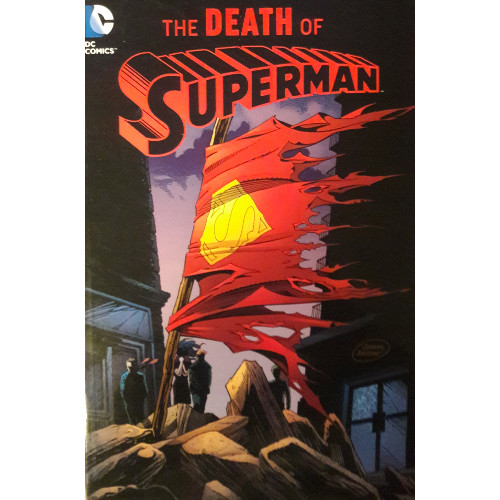
Faster than a speeding bullet. More powerful than a locomotive. Here to stand for truth, justice, and a better tomorrow (as of 2021, the catchphrase no longer ends with “the American Way”). You look up in the sky, and you don’t see a bird or a plane. You see Superman.
Since 1938, Superman has graced the pages of comics, saving the world on his own or alongside the Justice League and battling menaces to humanity such as Lex Luthor, Brainiac, the Parasite, Metallo, and Bizarro. After the epic Crisis on Infinite Earths crossover, Superman’s origin was updated and retold by John Byrne, who helped launch a new ongoing Superman series after the success of his Man of Steel limited series.
But in the early 90s, a few folks at DC felt like the actual Man of Steel was feeling less love than was shown his runaway series from a few years earlier. At a 1991 Superman summit, Jerry Ordway jokingly suggested they kill off the Big Blue Boy Scout–y’know, to thumb their noses at the world and basically go, “You don’t appreciate Superman? Fine, you can’t have him.”
So they did. Killed Superman, that is.
“The Death of Superman”
Writers: Dan Jurgens, Jerry Ordway, Louise Simonson, Roger Stern, Dennis Janke
Pencilers: Jon Bogdanove, Tom Grummett, Jackson Guice, Dan Jurgens, Brett Breeding, Dennis Janke
Inkers: Dennis Janke, Brett Breeding, Doug Hazelwood
Colorists: Glenn Whitmore
Letterers: Bill Oakley, John Costanza, Bill Pearson, Albert DeGuzman
Issues: Action Comics #684, Adventures of Superman #496-498, Superman #73-75, Superman: The Man of Steel #17-19
Publication Dates: December 1992-January 1993
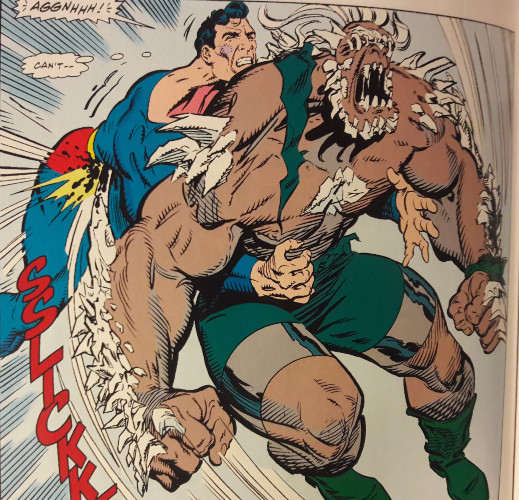
Note: save for some minor edits, this blog is the same as it was when I originally posted it to Hubpages
Most readers will be aware by now that Clark Kent’s red-and-blue alter ego is currently alive and well. Obviously, Superman didn’t stay dead, but the development of the ensuing sagas post-DoS should be given their due in other posts, should I choose to follow those threads.
For now, all we need to do is that Superman, in this story, dies.
Or kinda dies? We might get to that later.
Perhaps more importantly than the hero’s actual “demise” is the reaction to it. For me, this is the point of the story, and though it is more thoroughly unpacked in subsequent chapters, “Death of Superman” successfully brings the reader to that brink, ending with the violent final blows between Superman and Doomsday before leaving an ominous, heart-wrenching, shuddering quiet floating through the story’s last moments.
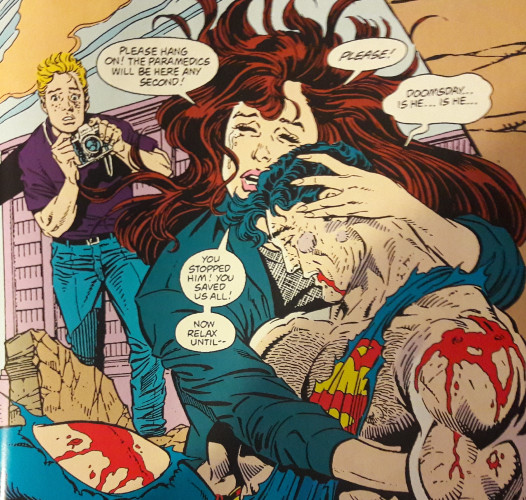
You close the book with Superman dead. And you wonder how the world will ever move on.
What’s astounding about “Death of Superman,” collectively, is the subtlety in which it moves forward. I noted previously how Crisis on Infinite Earths, though clearly an editorially mandated move to trim the number of universes within the DC Multiverse, cleverly encapsulates this order from on high within a story. I also mentioned how Jason Todd’s demise in “Death in the Family” is similarly subtle, despite its title. Several of these stories have cloaked their true intentions in shadow, reeling the reader in before bopping them over the head.
“Death of Superman” feels no different. Granted, with the benefit of nearly thirty years of hindsight, we can see the entire arc, start to finish. It’s hard to pick up any collection labeled “Death of Superman” and not immediately understand the story’s dramatic ending. Harder still is picking up the story initially completely oblivious to the narrative inside. I believe few people seek out this story for reasons other than seeing Supes bite the big one. But I wonder, when it was first published, how publicized this story’s culminating moment was. Only the final chapter’s cover bears the grim announcement of Superman’s approaching demise. Otherwise, the story is relatively free of the Reaper.
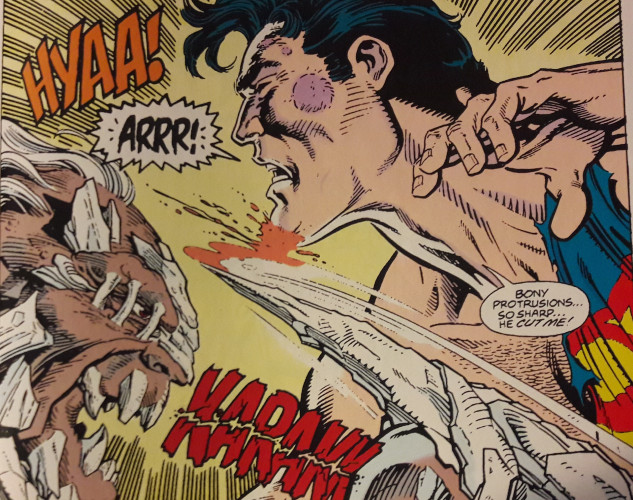
Does “Death of Superman” work well when you strip away its titular hero’s dramatic departure to the hereafter? In certain cases, yes. I was reminded often of the classic Roger Stern/John Romita Jr. two-parter, “Nothing Can Stop the Juggernaut,” told in Amazing Spider-Man #229-230 (that Stern also contributes to DoS is simply icing on the connectivity cake). In that tale, Spider-Man takes on the Juggernaut, a seemingly insurmountable opponent. Nearly everything he tries fails to take down his opponent. Here, too, Superman is charged with halting the rampage of the potentially unstoppable Doomsday, who cuts a swath of destruction across America after freeing himself from captivity.
The assembled writers work well in shrouding Doomsday’s background and intentions. He’s a living engine of devastation, tearing through highways, pulling down bridges, annihilating planes, and trouncing any defense mounted against him. He is fantastically simple in his creation and purpose–he lives to kill. That’s it. We’ve got no clever schemes, no sharp monologuing, no troubled past to guide his motives. He’s simply the Energizer Bunny of death.
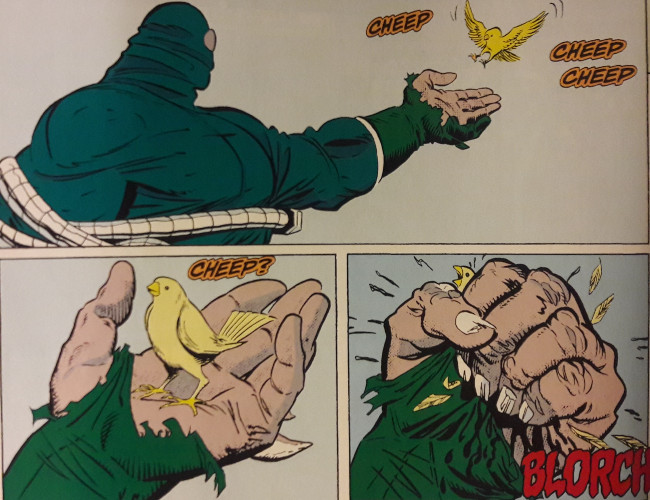
To me, such a creature makes perfect sense as the portended downfall of Superman. The world’s most invincible superhero is set against an unstoppable machine of rage and rampage. Later stories would label Doomsday as a Kryptonian creation and tether that into how he capably killed Superman. For this story, however, Doomsday is simply a powerhouse that pushes Superman to and then beyond the limits of his strength and invulnerability.
A guy like Spider-Man is always going to be outmatched, in a physical sense, by the Juggernaut. Hence, he utilizes his intelligence in defeating his opponent. But Superman, generally being stronger and more invulnerable than most other folks, requires a different type of foe to push him to, and then beyond, the brink. Doomsday just keeps moving, absorbing punishment from both Superman and the Justice League, yet never faltering in his single-minded devotion to destroy. In his mission, Doomsday represents the antithesis of Superman, a desire for death over life. Perhaps even worse, Doomsday represents a mindless, needless desire for death. He doesn’t swear to methodically upend everything Superman holds dear, but his presence alone makes him a threat. He doesn’t demand vengeance; people just get in his way.
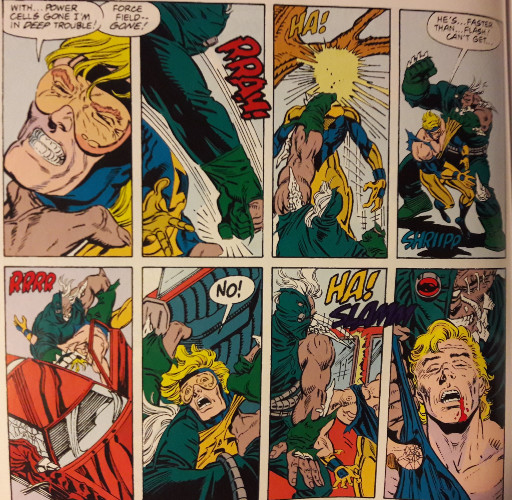
The Justice League themselves contribute engagingly to the plot. Until reading the story, I was unaware of their involvement. They actually tackle Doomsday first; it’s Booster Gold, swatted away from the creature, who coins the monster’s moniker. Knowing how memorable DoS is for Doomsday and Superman’s final confrontation, I feel the JLA’s involvement should receive more attention from reviewers and fans. They’re a generally weaker version of the team, from what I can tell. Instead of legends like Wonder Woman, Flash, Green Lantern, Aquaman, Batman, and others, you’ve got “second stringers” like Booster Gold, Blue Beetle, and a mysterious guy named Bloodwynd helming the group. In other words, they’ve got no shot against Doomsday.
Their appearance is needed, not just to set up the stakes, but to provide Doomsday with an initial obstacle. The team’s woeful attempts to intervene leave them bruised and busted, hinting at Doomsday’s incredible power and rage. Up until their involvement, the monster tears through highways and trucks and bridges. The scenes where Doomsday smashes the front grill of yet another truck eventually grow a tad stale. We get it, you can’t stop the guy. But once the League, and shortly thereafter Superman, become involved, Doomsday’s victims now have recognizable faces. It’s one thing watching pages of senseless destruction; it’s another to see Blue Beetle pulverized into a coma or Booster’s head slammed into a car door.
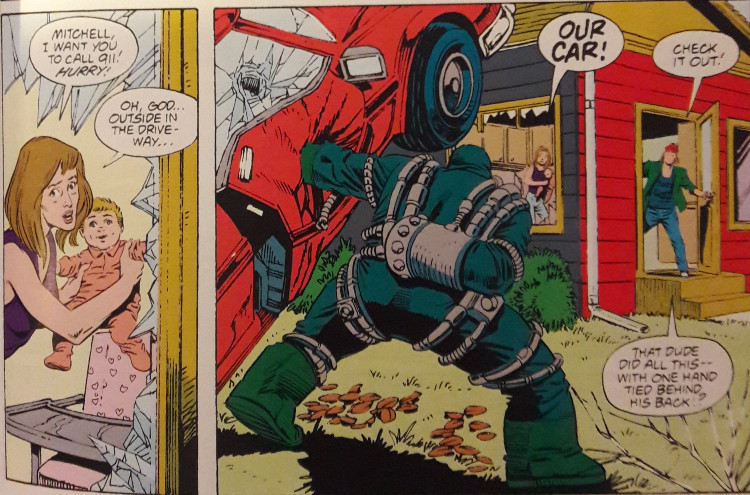
The writers themselves reach a point where they realize Doomsday’s journey needs some variety–one of the more engaging scenes sees Doomsday tear through a small town, demolishing the suburban home of a single mom and her kids. Writer/illustrator Dan Jurgens ratchets up the personal stakes, and his ability to include a brief aside with these characters points to the human toll Doomsday’s rampage has. So much of the fisticuffs involve hero vs. villain conflicts that the people, for a time, are set aside. But they suffer under Doomsday’s dark, damaging dominion as much, if not more, than the Justice League. Including these new characters, even for a spell, provides some decent variety.
The scene in question also sets up an interesting moral issue for Superman later on, one where he’s forced to choose between saving the life of an innocent or tackling Doomsday. The choice is heavy, appropriately philosophical. Let someone who he knows will die perish or keep the monster from potentially claiming many more lives? Again, it’s a brief scene, but it’s a nice break from the constant mano-a-mano warfare between Doomsday and his assembled opponents. DoS is paced better than I imagined it would be, and moments like this only help maintain a rhythm.
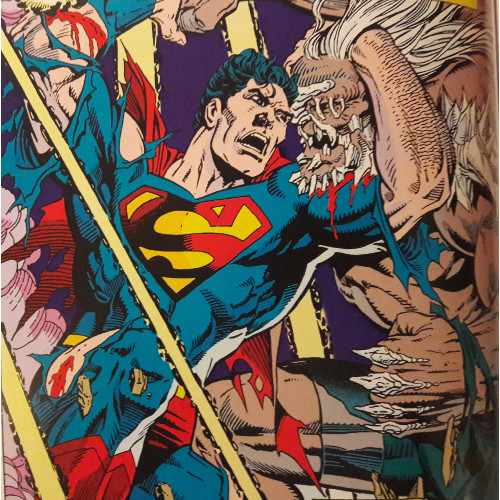
My primary complaint is how heavy-handed Superman’s mythos is crowded into here. The narrative isn’t necessarily a celebration of “everything Superman” as a way to herald his impending demise. As I mentioned earlier, the whole “Superman dies” bit isn’t even blatantly telegraphed. Heading into the story armed with the knowledge of its ending, however, I felt like several pieces were crammed in to capitalize on Supes’ then-current history. A whole variety of supporting cast members pop up, several of whom I am unfamiliar with but who I assume played roles in Superman comics at the time. Their appearances tend to coincide with where Superman and Doomsday’s final battle falls, sort of a coincidental “right place, right time” deal. It’s like the writers believed they had to push as much of Supes’ mythology as they could right before offing the guy.
The grand finale between the two adversaries also reads awkwardly. This last battle is shown in several full page panels stretching across an entire issue. The idea is great and, when used well, could really tell an engaging story (see Walt Simonson’s standalone Thor issue where the Thunder God takes on the Midgard Serpent for a great example of this). Perhaps it’s the formatting of the volume I own, or maybe it’s just how the whole thing was originally produced, but the issue feels a little awkward to read through. The panels feel stretched, as if they were illustrated like regular-sized comic book panels and then extended to the edges of the page. Additionally, while some moments in the comic feel like they deserve a full-page panel, or in some instances a double-page spread, several moments don’t need the full-page treatment. Scenes where Lois kisses Superman goodbye or where Ma and Pa Kent mourn the loss of their son in Smallville feel appropriate to this arrangement. But having every punch thrown, every blow between Superman and Doomsday told in this format actually limits the issue. Instead of feeling like this massive brouhaha, the whole thing feels like 38 panels stretched out across the same number of pages, almost as if you’re getting only a handful of pages of actual story instead of the weighty confrontation the battle deserves.

For interested readers, I would highly suggest picking up a volume of this story also collecting the “Newstime: The Life and Death of Superman” one-shot. This fake newspaper delves deep into the world’s reaction to the Man of Steel’s death, featuring articles on Doomsday, how a world without Superman functions, and sound bites from comic book characters (like Cat Grant and Bruce Wayne) to real celebrities (like John Goodman). The whole piece is wonderfully polished, garnished with ads for Wayne Tech, LexOil, Ferris Air, and the Camelot 3000 motorcar (a nod to the DC Comics limited series of the same name by Mike W. Barr and Brian Bolland). It feels as authentic as a fake magazine could feel and really expounds upon how dramatic the loss of Superman really was to the DC Comics world. It really sticks the “You can’t have Superman” message to the readers, validating his death and affirming the weight of such a temporarily permanent decision.
“Death of Superman” is imperfect and, yes, it would be overturned a short while later, but the story itself remains engaging. Despite its flaws, the narrative doesn’t feel like an intentional cash grab on DC’s part or an attempt to make global headlines in our world. The story does admittedly feel emotionally manipulative, with DC letting readers feel like they didn’t know what they had in Superman until he was gone. Simultaneously, however, DoS is constructed in a way that emphasizes Superman’s character and strengths; in killing him, the story celebrates what made him so heroic in the first place: his innate goodness, character, and fortitude, his willingness to fight to the last. Here was a character who was always willing to defend and protect until his dying breath who actually did that. That’s what makes a Superman, this story says, and we’re all a little worse off without him.